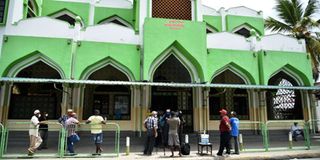How benign mosque became face of radicalisation in Mombasa

Masjid Musa in Mombasa.
What you need to know:
- Rogo was on US sanction list for allegedly supporting the Al-Shabaab in Somalia.
- Then on August 27, 2012, he was killed in a drive-by shooting by unknown assailants.
- Makaburi was felled by a hail of bullets as he left the Shimo La Tewa Maximum Prison in 2014.
- In Kisauni, Swafaa and Minaa mosques have also stopped preaching hate.
The Masjid Musa in Mombasa is not your ordinary mosque.
For a couple of years between 2011 and 2013, it was the base of radicalisation. Located deep in Majengo, it’s where two firebrand clerics, Aboud Rogo and Abubakar Shariff alias Makaburi, frequently preached fiery sermons.
Rogo was on US sanction list for allegedly supporting the Al-Shabaab in Somalia. He was “engaging in acts that directly or indirectly threaten the peace, security or stability of Somalia”, the Americas said.
Then on August 27, 2012, he was killed in a drive-by shooting by unknown assailants.
Makaburi was felled by a hail of bullets as he left the Shimo La Tewa Maximum Prison in Mombasa on April 1, 2014 as he awaited a decision from the Shanzu Law Courts, where he had applied for easing of his bail conditions.
In both cases, the killings angered their followers, who engaged the police in running battles. Eventually, the violence was contained.
Abandoned radical ways
For the past five years, things have been quiet at the Masjid Musa. The Musa and Sakina mosques in Majengo have also abandoned their radical ways.
In Kisauni, Swafaa and Minaa mosques have also stopped preaching hate.
But that does not mean the region is safe; that religious intolerance is no more.
Intelligence reports show that a majority of Rogo’s followers moved to Kwale County and turned the south Coast into a recruitment zone for Al-Shabaab.
Active terror cells
There were active terror cells in Bongwe, Mwaluvamba, Mbita, Shamu, Kilolapwa and parts of Ng’ombeni, which borders Mombasa and Kwale counties.
“It’s not that there were no activities in Kwale (at the time of Rogo and Makaburi), it’s just that the leaders were in Mombasa,” said a police source from the Anti-Terror Police Unit (ATPU).
Most of the youths who attended the sessions at the Masjid Musa were from Kwale.
Last year, detectives identified four Al-Shabaab recruiters who were targeting the youth.
Disguised operations
To disguise their operations, they invested heavily in community projects.
“They dug boreholes for free, promising the youth better jobs in Somalia,” said a community policing official who has been helping the government in dealing with radicalisation in the area.
“Recruitment has been ongoing in the interior parts of Kwale. Some youths were lured by false promise of being taken to madrasa (religious studies). To date, their parents have not heard anything from them,” said another source.
Hassan Mwakimako, an associate Professor of Islamic Studies at the Department of Philosophy and Religious Studies at Pwani University, attributes the shift of terror activities to Kwale to the killings of the Mombasa clerics.
The port city had become a dangerous ground for them. They had to flee.
While authorities have decimated many Al-Shabaab cells in the region, Kwale remains tricky, thanks to runaway unemployment, and marginalisation.
Because of the community set up, where one sub-tribe of the Mijikenda — Digo — is dominant, locals are held together by strong valves of secrecy.
“They are fighting for the same thing (community needs) and that is why it’s hard for other residents to report those involved in the activities. It’s also why some of the challenges they face have never been resolved by the government,” says Prof Mwakimako.
Terror suspects
Muslims for Human Rights (Muhuri) rapid response officer, Francis Auma, who has been handling cases of alleged extra-judicial killings of terror suspects, said some radicalised youths regularly sneak into the country from Tanzania.
In partnership with the United Kingdom, the government recently launched a Sh60 million state-of-the-art facility at the Coast to be used in intelligence sharing to prevent terror attacks.
The Director of Criminal Investigation (DCI), George Kinoti, said the centre will also help the multi-agency team to dismantle terror cells at the Coast.
“We have modernised our equipment at the Coast because we are aware terror cells are active here. We will be able to disrupt, prevent and deter any terrorist activities risk before they happen because of the information that we will be receiving from here,” said Mr Kinoti
Most of the youths who had joined Al-Shabaab in Somalia before sneaking back into the country have since been killed by officers from the ATPU.
They are Mohammed Mwatsumiro alias Modi, who was linked to the Dusit D2 suicide bomber Mahir Riziki, Suleiman Ali Kodza alias Pembe, Kennedy Okaka and Mohamed Mapenzi.
Others are Swaleh Yusuf Abdalla, Salama Salim Mohamed and Mkubwa Sadi Ramadhan.
“Killing of these sspects won’t end terrorism in Coast. Police must respect the rule of law and use the required means to deal with this menace. That’s when we will win the war on terror because more people will be willing to join the fight. Otherwise, killing cannot be justified,” said Mr Auma.
As opinion differ on how to handle the terror suspects and the radicalisation, Kwale continues to be the remaining base of radicalisation and extremism at the Kenyan coast.





